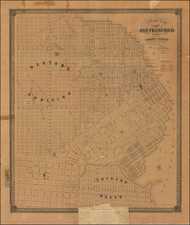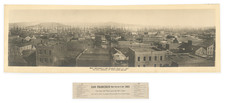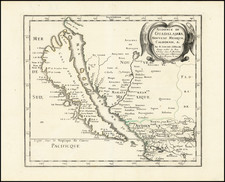"The First Privately Printed Map of the Gold Region Based Upon Actual Observations" (Carl Wheat)
Rare and highly important early map of the California gold region, which Wheat regarded as the most important printed map of the California Gold Region printed in 1849.
James J. Jarves' map of the gold regions of California is a landmark map in cartographic history of the gold regions and the earliest reasonably accurate privately printed map of the gold region based upon personal observations.
Streeter (#2540) notes:
Wheat gives an extended account of Jarves and this map . . . concluding his account with, "From many points of view Jarves' map is one of the most interesting and important of the early gold region maps."
In the introduction to The Maps of the California Gold Region, Wheat makes a strong case for the primacy and importance of Jarves' map, as the first privately printed map of the gold region based upon actual observations. Wheat states:
During [1848] all the larger map publishers . . . brought out maps of the western country with . . . the "Routes to California" for the guidance of the departing gold seekers . . . but none of these maps attempted to show details of the gold-bearing area . . .
Before the year 1849 was out, however, there appeared a few maps on which the results of personal observation were delineated, among them those of Jarves, Jefferson, Reading and Wilkes. . . . [Jarves] map states that it was the result of a survey of the diggings made for him in June, 1849. It was published before the close of that year by James Munroe & Co. of Boston, and purported to disclose " all the new Towns, Ranches, Roads [and] Dry & West Diggings," with the distances between them. The rapid advance of the army of gold-seekers into the interior is graphically shown, their progress having already borne fruit in the appearance of Stockton, as well as of a number of "mushroom cities," such as New York, Webster, Sparks, and Boston which loom large on Jarves' well drawn-map. In the gold regions themselves, Angels Camp and "Dry Diggings" (later Placerville) have appeared and numerous conventional marks, signifying "Diggings," are placed along the courses of the several mountain streams.
Regarding the other 3 maps, 2 (Jefferson and Wilkes) are not focused on the gold regions, while Reading's map is a manuscript map, which exists in a single copy (California State Library). Accordingly, it may be fairly stated that Wheat regarded Jarves' map as the first privately printed map of the Gold Region with any meaningful degree of accuracy, which was printed from actual observations.
James Jackson Jarves was born in Boston in 1818. As a result of an illness when he was 15 years old, he travelled to Hawaii and later South America, publishing several books, including History of the Hawaiian or Sandwich Islands and Scenes and Trip Through Central America. He made two subsequent trips to Hawaii, during which time he began his career as a Journalist, and served as the editor of the first newspaper in Hawaii. Jarves was commissioned to serve as trade consul by the Hawaiian Government to negotiate commercial treaties with the United States, England and France, leaving Hawaii in February 1848.
The April 1, 1848 issue of the California Star notes Jarves' arrival, shortly after the discovery of gold in California. Jarves apparently remained in California for approximately 1 year, during which time he was likely primarily engaged in the business of securing commercial trade treaties with the US Government, although he apparently had sufficient time to commission this map. By September 1849, Jarves had arrived in Washington and consumated a commercial trade treaty with the United States, on behalf of the Kingdom of Hawaii, which was signed in Washington on September 20, 1849.
Jarves would next travel to Europe in his capacity as Hawaiian Trade Consul, but would ultimately return to journalism and art collecting. Jarves would go on to become one of the most important art collectors and writers of the 19th Century, amassing several major collections that are now owned by the New York Metropolitan Museum of Art and Yale University and writing a number of important books on art.
The lack of information on Jarves' activities in California between his arrival in the Spring of 1848 and his departure for the East Coast of the United States is quite extraordinary. By 1848, Jarvis had published at least 3 books regarding his travels and served as the editor of Hawaii's first newspaper. By 1852, he had published yet another book on his experiences in France. It stands in stark contrast to his prolific propensity for writing about his travels that there is virtually no record of his time in California, especially given the newsworthiness of any report from California in 1848 and 1849. While it is possible that his archives include additional information regarding his time in California, we are left to speculate on his non-official activities which led to the making of the map. It may be surmised that his interest in an accurate map of the region was fomented by Thomas O. Larkin, US Trade Consul in California, with whom Jarves corresponded between 1845 and 1849, and whose map of the Gold Regions of California, also lithographed by Bufford & Co. in Boston (1848), is regarded as the first privately printed map of the gold regions (although it is merely a tracing of Biddle's map of 1844).
States of the Map
The present example is one of two variant states published in 1849, this edition having Jarves' name correctly spelled (rather than Jarvis) and with James Munroe listed as the publisher below the title. The map was re-issued in London in 1850 by Hullmandel & Walton, with the revised title A Correct Map of the Bay of San Francisco and the Gold Region to April 1850. From the best information in the Country. Embracing all the New Towns, Ranchos, Dry and Wet Diggings, with their several distances from each other [above neat line at lower right] Hullmandel & Walton Lithographers London.
Rarity
The map is of the utmost rarity, with OCLC locating only 2 examples (Yale and UC Santa Cruz). We also note copies in the Bancroft and California State Libraries. The map has appeared at auction on only 3 occasions in the 20th Century, Holliday Sale #568 (1954), Streeter #2540 (1968) and the Ebserstadt remainder sale (Sothebys, 1985), where a shabby copy, heavily browned and stained with loss of image brought $2,420 in a small lot by High Ridge Books (Catalog 9, #123).
The present example lacks the original covers. We have located only one record of a folded example of the map. The example illustrated by Wheat is in relatively poor condition, with significant browning, staining and loss of image.
Jarves was the son of Deming Jarves (1790-1869), an inventor and Anna Smith Stutson (Jarves).
After attending Chauncy Hall School in Boston, Jarves was briefly disabled with a strange disease at age 15. Though recovering, he sought warmer climes. He traveled to South America and Hawaii in 1837. There he tried journalism and silkworm husbandry before returning to Boston in 1840.
Jarves published several travel recollections, including History of the Hawaiian or Sandwich Islands and Scenes and Trip Through Central America. A second try at newspaper publishing in Hawaii in 1844 resulted in a second incarnation of the Polynesian, which the Hawaiian government bought as their official organ.
In 1848 Jarves returned to the United States where he negotiated treaties for the island kingdom. Jarves traveled to Europe in 1851 which captured his interest so profoundly, he seldom returned to the States and never again to Hawaii. A book of Parisian experiences, Parisian Sights and French Principles (1852) preceded his settling permanently in Florence.
Jarves became part of the ex-patriot cultural community there, which included the Brownings and Anna Jameson. In Florence, Jarves began his career as an art writer. His first work was an art primer for American audiences, Art-Hints, Architecture, Sculpture and Painting,1855. A travelogue filled with art description, Italian Sights and Papal Principles followed in 1856. Jarves also began assembling art collections for himself and others, focusing personally on the early Italian masters. In 1859 he approached Charles Eliot Norton hoping to sell his art collection. Norton declined and Jarves spent the next years vainly trying to recoup his investment. Jarves' Art Studies: The "Old Masters" of Italy, Painting was published in 1861.
In 1864, his most important work, The Art Idea: Part Second of Confessions of an Inquirer made press. It had first appeared as part II of his confessional Why and What I Am? The Confessions of an Inquirer (1857). In addition to the text, the book contained an essay on Jarves' personal principles of collection, based upon two earlier books by Alexis Rio and Lord Alexander Lindsay. Jarves' collecting and writing promoted the less-realistic but (as he saw it) more (Christian) spiritual dugento Italian painting over the later periods. Art Thoughts, the Experiences and Observations of an American Amateur in Europe (1869), followed. His Glimpse of the Art of Japan, 1876, was written without a trip to the country.
In the late 1870s, Jarves assembled a collection of drawings (including nine Michelangelos, two Raphaels, nine Rembrandts, and examples by Titian, Tintoretto and Leonardo) which he sold to Cornelius Vanderbilt (1794-1877), a significant enough collection to get Vanderbilt on the board of the Metropolitan Museum of Art. The Met, however, turned down an offer to buy his important Italian paintings. Instead, Yale University took them as collateral on a loan; when Jarves defaulted, a significant portion of his painting collection was acquired by Yale for $22,000 in 1871. A second part was sold in 1884 to Liberty E. Holden (1833-1913) who donated it to the Cleveland Museum of Art. Jarves served vice consul for the United States in Florence between 1880 and1882. Isabella died in 1887. The following year while vacationing in Switzerland, Jarves contracted jaundice and died. He is buried in the Protestant (English) cemetery in Rome.
Jarves is an example of the great 19th-century amateurs who helped develop American art collections, aesthetics, and popular interest in art history. The orderly historic method in his Art-Idea reflects the particular influence of the 1847 Sketches of the History of Christian Art of Alexander Lindsay (Rowland). In Art-Idea, Jarves defines art as the increasingly-naturalistic progression of objects which edify and and re-enforce morality. But Jarves distrusted the (Roman Catholic) church as commissioner of renaissance art. He praised Greek art for having thrown off the bonds of religiosity. Like most historians who defined the progress of art as ever-increasing naturalism, he was dismayed by Manet's Olympia (for example) because of the regression it seemed to make in flat painting. Today, Jarves is most consulted for his opinions, considered typical, on American artists. He disparaged Copley, considered Thomas Cole "greater in idea than action . . . " and praised Elihu Vedder. From John Ruskin, Jarves borrowed the idea of state support for the arts and a predilection for building modern construction in gothic architecture instead of renaissance. The quattrocento sculptor Apollonio di Giovanni (di Tomaso) was known as the "Master of the Jarves Cassoni" before being securely identified, from the Jarves example in Yale's collection.









![[Three Vintage Frank Kettlewell Cartoons]](https://storage.googleapis.com/raremaps/img/small/68562.jpg)


![[Alaska to San Diego and San Qunitin, British Columbia] A Chart Shewing Part of the Coast of N.W. America, with the Tracks of His Majesty's Sloop Discovery and Armed Tender Chatham . . . (First Modern Map of the West Coast of North America)](https://storage.googleapis.com/raremaps/img/small/102067.jpg)

